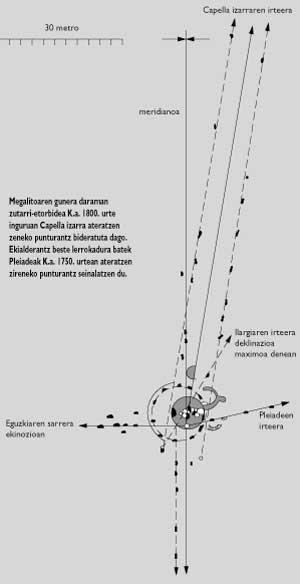Advertising stars
However, although the timeframes to be monitored or measured were longer, the need was evident. Already in the Upper Palaeolithic the first simple calendars were worked from the monthly cycle of the Moon. The need for calendar was accentuated in the Neolithic with the development of agriculture. It was vitally important to know when the seed had to be sown so that it would then become alert without losing. But, of course, these needs require a calendar based on the Sun, which is what generates the seasons of the year. In some cases, however, some peoples of prehistory and protohistory solved the problem differently. The solution was based on the observation of luminous stars.

An example of this solution is the astronomical discovery of the Egyptians “Elhuyar. We spoke in issue 72 of the magazine “Science and Technology”. Then we said that the Egyptians took care of the heliac exit of the star Sirius (which they called Sothis) to know when the Nile floods would begin. Let's look at two similar examples. In these cases, we should not go back in history, as there are two countries currently residing in Brazil and Australia. In the first, the tucanos that inhabit the Amazon, take care every year the few days in which the Pleiades hide behind the Sun to start sowing the seed. The astronomical phenomenon we have referred to is the helium occultation of the Pleiades, which has its importance because it occurs shortly before the beginning of the rain. The second case is that of an Australian tribe. They observe the Arcturus helium hideout to catch one of the bases of their feeding (ants).
It should not be said that the Pleiades have no influence on rain in the Amazon or on ants by Arcturus, but because they are cyclical astronomical phenomena, their concordance has special importance for the peoples mentioned with the seasons of the year and makes them useful for their delimitation. That is why they are part of the calendar of these cultures and therefore we can consider them as star advertisers.
The example below does not correspond to the position of a single star and to some extent we could say that it is a simple observatory. We talk about the Callanish megalith, which is located in the Hebridas archipelago on the island of Lewis. It is another example of the megalithic culture that spread throughout Europe about four thousand years ago. However, it has an interesting difference with other monuments of the same culture in relation to the subject that concerns us. The most spectacular and large megaliths have astronomical orientations according to special directions.
These directions are mainly related to the special positions of the Sun and the Moon, but in the case of Callanish some column alignments are oriented towards the outlet points of the luminous stars. As can be seen in the image, the avenue of the pillars that leads to the area of the megalito a. C. Direction towards the starting point of the star Capella towards 1800. Another alignment to the east Pleiades a. C. It points to the starting point in 1750. Although some researchers claim that the first alignment is controversial, the dates mentioned may be considered as dates of construction of the megalith, since they coincide with other archaeological criteria.
Although the astronomical objectives of Callanish's megalith seem evident, the objectives and uses of this megalith and the like have not yet been clarified.






